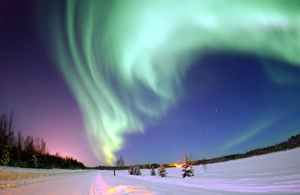Scientists and weather analysts are predicting that solar flares caused by geomagnetic storms could disrupt telecommunications, satellite and electric equipment this week.
With the sun set to reach the maximum of its 11-year cycle next year, this is increasing the frequency of solar flares that spark aurorae displays similar to the aurora borealis one sees in the northern latitudes such as Alaska, northern Scandinavia, parts of Canada, Russia and the Arctic.
NASA describes a solar flare as an explosion on the sun that happens when energy stored in twisted magnetic fields (usually above sunspots) is suddenly released.
Such flares produce a burst of radiation across the electromagnetic spectrum, ranging from radio waves to x-rays and gamma-rays.
Massive bursts of solar wind, known as coronal mass ejections (CMEs), or ‘solar burps’, are associated with solar flares.
Last Friday, a widespread display of aurorae erupted when a double-CME hit the Earth’s magnetic field and sparked a G4 category geomagnetic storm, according to NASA. As well as in Canada, the Northern Lights could be seen in the US in states such as Utah, Colorado and Nebraska. NASA got reports from people in the UK, Poland and Germany who also witnessed the aurorae.
Sunspot 1263 – posing a threat of x-class solar flares
It says Sunsport 1263 is posing a continual threat for x-class solar flares.
There are three categories of solar flares: x-class flares are big and can trigger planet-wide radio blackouts and long-lasting radiation storms, says NASA. M-class flares are medium-sized and can cause brief radio blackouts that affect Earth’s polar regions. C-class flares are small and have few noticeable consequences for planet Earth.
“The magnetic storm that is soon to develop probably will be in the moderate to strong level,” Joseph Kunches, a space weather scientist at the Space Weather Prediction Center, told Reuters today.

The aurora borealis shining above Bear Lake in Alaska
Solar superstorm of 1859
The strongest solar storm ever recorded happened on 1-2 September 1859. It caused aurorae to be seen all over the world, while telegraph systems in Europe and North America also failed, with pylons emitting sparks. British astronomer Richard Carrington and Richard Hodgson were the first scientists to independently make observations of a solar flare during the 1859 storm when they viewed a large flare in white light.
Photo: Lance Taylor took this photograph of the geomagnetic storm that affected the earth last Friday night and submitted it to Spaceweather.com. He took the photo at Cooking Lake Blackfoot area near Edmonton, Alberta, and observed the display from 10pm until 3am. “After the geomagnetic storm we were then treated to a fantastic thunderstorm with a freakish amount of ground strike lightning in it. An amazing and memorable night of observing indeed,” said Taylor